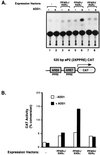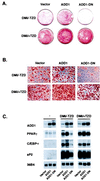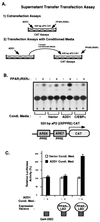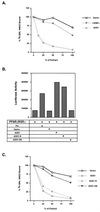ADD1/SREBP1 activates PPARgamma through the production of endogenous ligand
- PMID: 9539737
- PMCID: PMC22489
- DOI: 10.1073/pnas.95.8.4333
ADD1/SREBP1 activates PPARgamma through the production of endogenous ligand
Abstract
Adipose differentiation is an important part of the energy homeostasis system of higher organisms. Recent data have suggested that this process is controlled by an interplay of transcription factors including PPARgamma, the C/EBPs, and ADD1/SREBP1. Although these factors interact functionally to initiate the program of differentiation, there are no data concerning specific mechanisms of interaction. We show here that the expression of ADD1/SREBP1 specifically increases the activity of PPARgamma but not other isoforms, PPARalpha, or PPARdelta. This activation occurs through the ligand-binding domain of PPARgamma when it is fused to the DNA-binding domain of Gal4. The stimulation of PPARgamma by ADD1/SREBP1 does not require coexpression in the same cells; supernatants from cultures that express ADD1/SREBP1 augment the transcriptional activity of PPARgamma. Finally, we demonstrate directly that cells expressing ADD1/SREBP1 produce and secrete lipid molecule(s) that bind directly to PPARgamma, displacing the binding of radioactive thiazolidinedione ligands. These data establish that ADD1/SREBP1 can control the production of endogenous ligand(s) for PPARgamma and suggest a mechanism for coordinating the actions of these adipogenic factors.
Figures




Similar articles
-
Dual DNA binding specificity of ADD1/SREBP1 controlled by a single amino acid in the basic helix-loop-helix domain.Mol Cell Biol. 1995 May;15(5):2582-8. doi: 10.1128/MCB.15.5.2582. Mol Cell Biol. 1995. PMID: 7739539 Free PMC article.
-
Obesity-related overexpression of fatty-acid synthase gene in adipose tissue involves sterol regulatory element-binding protein transcription factors.J Biol Chem. 1998 Oct 30;273(44):29164-71. doi: 10.1074/jbc.273.44.29164. J Biol Chem. 1998. PMID: 9786926
-
ADD1/SREBP1 promotes adipocyte differentiation and gene expression linked to fatty acid metabolism.Genes Dev. 1996 May 1;10(9):1096-107. doi: 10.1101/gad.10.9.1096. Genes Dev. 1996. PMID: 8654925
-
Modulating the transcriptional control of adipogenesis.Curr Opin Genet Dev. 1997 Oct;7(5):603-8. doi: 10.1016/s0959-437x(97)80006-8. Curr Opin Genet Dev. 1997. PMID: 9388775 Review.
-
Peroxisome proliferator-activated receptor gamma and the control of adipogenesis.Curr Opin Lipidol. 1997 Aug;8(4):212-8. doi: 10.1097/00041433-199708000-00004. Curr Opin Lipidol. 1997. PMID: 9253537 Review.
Cited by
-
Inhibition of Notch uncouples Akt activation from hepatic lipid accumulation by decreasing mTorc1 stability.Nat Med. 2013 Aug;19(8):1054-60. doi: 10.1038/nm.3259. Epub 2013 Jul 7. Nat Med. 2013. PMID: 23832089 Free PMC article.
-
Zinc finger protein 407 overexpression upregulates PPAR target gene expression and improves glucose homeostasis in mice.Am J Physiol Endocrinol Metab. 2016 Nov 1;311(5):E869-E880. doi: 10.1152/ajpendo.00234.2016. Epub 2016 Sep 13. Am J Physiol Endocrinol Metab. 2016. PMID: 27624101 Free PMC article.
-
Peroxisome Proliferator-Activated Receptors and Caloric Restriction-Common Pathways Affecting Metabolism, Health, and Longevity.Cells. 2020 Jul 16;9(7):1708. doi: 10.3390/cells9071708. Cells. 2020. PMID: 32708786 Free PMC article. Review.
-
Antiadipogenic Effects of Aster glehni Extract: In Vivo and In Vitro Effects.Evid Based Complement Alternat Med. 2013;2013:859624. doi: 10.1155/2013/859624. Epub 2013 Jun 20. Evid Based Complement Alternat Med. 2013. PMID: 23864899 Free PMC article.
-
An Overview of the Role of Peroxisome Proliferator-activated Receptors in Liver Diseases.J Clin Transl Hepatol. 2023 Dec 28;11(7):1542-1552. doi: 10.14218/JCTH.2023.00334. Epub 2023 Nov 15. J Clin Transl Hepatol. 2023. PMID: 38161499 Free PMC article. Review.
References
-
- Spiegelman B M, Flier J S. Cell. 1996;87:377–389. - PubMed
-
- Tontonoz P, Hu E, Graves R A, Budavari A I, Spiegelman B M. Genes Dev. 1994;8:1224–1234. - PubMed
-
- Lehmann J M, Moore L B, Smith-Oliver T A, Wilkison W O, Willson T M, Kliewer S A. J Biol Chem. 1995;270:12953–12956. - PubMed
-
- Forman B M, Tontonoz P, Jasmine C, Brun R P, Spiegelman B M, Evans R M. Cell. 1995;83:803–812. - PubMed
Publication types
MeSH terms
Substances
Grants and funding
LinkOut - more resources
Full Text Sources
Other Literature Sources
Research Materials

